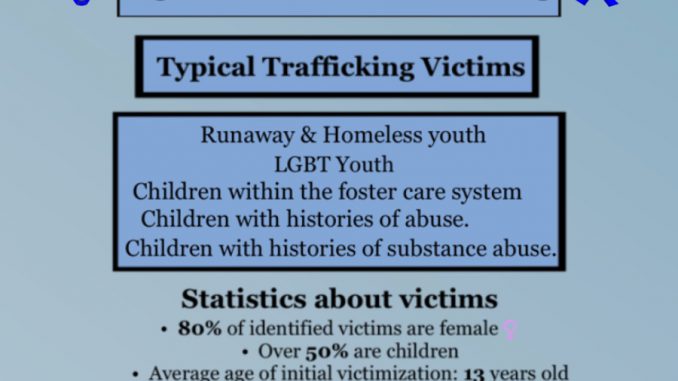
By Elly Herrick/Staff Writer

Some people think that human trafficking — the trade of humans for forced labor, sexual slavery, or commercial sexual exploitation — doesn’t happen in the U.S., let alone in Kenosha.
But every year, about 199,000 victims know the truth.
The $150 billion global crime industry targets children and adults, primarily females. Law enforcement warns that the stretch between Milwaukee and Chicago, including Kenosha and Racine counties, is prime hunting ground. The Greater Racine Human Trafficking task force has rescued more than 250 people in the last four years.
One Indian Trail High School & Academy sophomore came close to becoming a victim six years ago at a summer party, and the incident still haunts her today.
“It started when a car came by and we saw flashing lights coming from the car,” said the teen, who requested anonymity. “Nobody thought about it that much until after the same car kept on going past our neighborhood, over and over and over again.”
It was only the beginning.
“We were walking home from school because all [of my friends] walked together in a group,” she said. “The car stopped and they asked us once if we wanted a ride home.”
The group rejected, then noticed a huge dog in the driver’s backseat.
“He told us that if we didn’t go with him that the dog was going to come after us and bite us.” she said.
The group was close to a local convenience store, where they ran to safety.
“We had to ask the person behind the counter to call the police because we didn’t know what was going on,” she said.
After a visit from a police officer a week later, the IT student — at the time a fourth grader — received some chilling information.
“We found out that the guy who tried to traffic us lived like a street over, and he’d been [trafficking people] for a while,” she said.
The man had been arrested before.
“I still haven’t completely recovered,” she said. “I physically cannot get myself to walk out of a public place knowing that I have to walk by myself.”
“I carry a pen with me everywhere to write down a license plate number if we start to see a car over and over,” said the IT sophomore.
“A lot of kids sneak out, and they do it by themselves,” she said. “A lot of bad stuff can happen when you’re by yourself, and I know not to do that because I know what could happen.”
Outright kidnapping in trafficking is rarer than other approaches used by traffickers. What they do instead is much more subtle, authorities warn. Traffickers go to common places to find their victims, like malls, schools, and most importantly, the internet.
Statistics show an 800 percent increase in grooming, a process traffickers use to gain information and trust to manipulate victims over the internet, according to Lacey’s Hope Project, a survivor-founded nonprofit organization based in Jackson, Wis. The project’s mission is to fight sex trafficking through community awareness and education. Traffickers can use social media to access a multitude of victims.
It starts as a friendly relationship filled with promises. Once a victim trusts them, traffickers start asking favors. They say that the victim “owes” them something and use personal information to blackmail their victim.To lower these rising statistics is to be informed about what traffickers do and how they do it.
IT senior Livy Shreve expresses the need to take action.
“The reason why it’s such a big problem is it can be really hard to spot those kinds of people,” Shreve said.
Locations for victims being sold are usually at truck stops, according to the National Human Trafficking Hotline website. Victims walk out in public with their heads down and are visibly uncomfortable, not saying a word. Authorities urge people who see such a scene to call the 24-hour National Human Trafficking Hotline at 1-888-373-7888 or call 911 and ask for a human trafficking specialist.
Shreve took self-defense classes with her mom and sister out of concern over the issue.
“We took it because there was an increasing number of reported kidnapping and human trafficking around the Kenosha area,” she said.
During those classes, Shreve learned a lot.
“One thing I didn’t expect to learn, but I was really happy I did, is ways to make yourself look less like a target,” she said.
Some ways include being aware of one’s environment, never going to public places alone, and watching ones car, food or drink for possible tampering.
“One big thing I do, especially if I’m out with girls, is I do not have my phone out at all, especially if I’m out on the street,” Shreve said.
“You can’t trust everyone you see and that’s just the sad reality, ” she said. “You can trust that [your friends] can be safe, but you can never guarantee it.”
Life expectancy for young men and women in trafficking is seven years.
“My biggest fear is losing one of those guys,” Shreve said.
